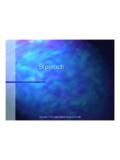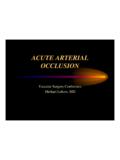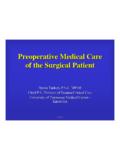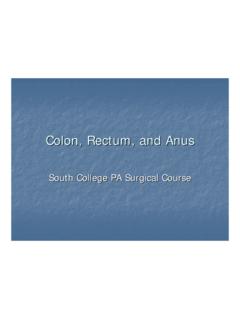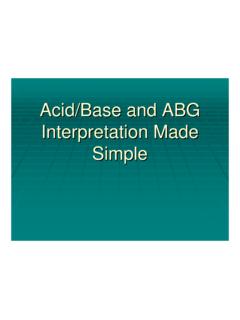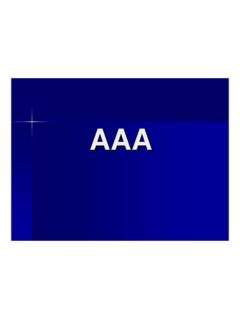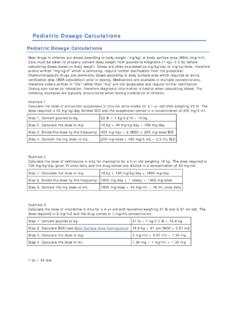Transcription of Surgery and Acute Renal Failure - The University of ...
1 Surgery Surgery and and Renal FailureRenal FailureGeneral loss of kidney function with alterations in volume regulation and ionic composition of body fluids and inadequate excretion of metabolic RateFiltration Rate Most practical measure of Renal functionMost practical measure of Renal function GFR(mlGFR(ml/min) = /min) = ((140 140 age) x weight (kg)age) x weight (kg)72 x serum 72 x serum creatininecreatinine GFR(mlGFR(ml/min) = /min) = (140 (140 age) x weight (kg)age) x weight (kg)x x serum 72 x serum creatininecreatinineAssumes stable creatinineconcentrationAcute Renal failureAcute Renal Failure 55--10% of surgical patients10% of surgical patients 25% of patients receiving CPB25% of patients receiving CPB PostPost--op op half of all requiring Acute half of all requiring Acute Anesthetic agents, blood products, tissue Anesthetic agents, blood products, tissue injury, sepsis, antibiotics, surgical fluid injury, sepsis, antibiotics, surgical fluid loss, loss, nephrotoxinsnephrotoxinsAcute Renal failureAcute Renal Failure OliguricOliguric less than 400cc urine per 24 less than 400cc urine per 24 hourshours NonNon--oliguricoliguric large volumes of urine large volumes of urine without clearance of protein metaboliteswithout clearance of protein metabolites AnuriaAnuria Bilateral artery occlusion, Bilateral artery occlusion, ureteralureteralligationligation, cortical necrosis, rapidly , cortical necrosis.
2 Rapidly progressive progressive glomerulonephritisglomerulonephritisAcut e Renal FailureAcute Renal Failure Most common cause, postMost common cause, post--op op ATNATN--sepsis, ischemia, sepsis, ischemia, nephrotoxinsnephrotoxins--pigmented granular castspigmented granular casts Acute cortical necrosisAcute cortical necrosis--profound shockprofound shock--disseminated intravascular coagulationdisseminated intravascular coagulation AtheroemboliAtheroemboli--vascular proceduresvascular procedures--anticoagulantsanticoagulants PrePre--renalrenal Impaired Renal perfusionImpaired Renal perfusionzzHypotension Hypotension sepsis, anaphylaxis, sepsis, anaphylaxis, neurogenicneurogenicshock, anesthesiashock, anesthesiazzHypovolemiaHypovolemia hemorrhage, dehydration, hemorrhage, dehydration, third spacingthird spacingzzRenovascularRenovascularobstruc tion obstruction embolic, embolic, atherosclerosis, venous atherosclerosis, venous thrombosithrombosizzCardiac Failure Cardiac Failure MI, MI, cardiomyopathycardiomyopathy, , Obstructive Obstructive uropathyuropathy-- Renal pelvis and Renal pelvis and uretersureters stone, clot, stone, clot, tumor, infection, retroperitoneal tumor, infection, retroperitoneal fibrosisfibrosis--bladder and urethra bladder and urethra obstructed obstructed bladder neck.
3 ExtravasationExtravasation--traumatrauma 5% of all cases of ARF5% of all cases of ARFI ntrarenalIntrarenal ATNATNI schemiaIschemiaNephrotoxinsNephrotoxins- -endogenous: pigments, crystals, or endogenous: pigments, crystals, or tumors (tumors (lysislysisor or myelomamyeloma))--exogenous: antibiotics, anestheticsexogenous: antibiotics, anestheticschemotherapeutic drugs, chemotherapeutic drugs, immunoimmuno--suppresantssuppresants, contrast, organic , contrast, organic solvents, solvents, GlomerulonephritisGlomerulonephritis--po stinfectiouspostinfectious: streptococcal, viral, IAA: streptococcal, viral, IAA--MembranoproliferativeMembranoprolif erative--Rapidly progressive: SLE, Rapidly progressive: SLE, GoodpastureGoodpasture ss, , PolyarteritisPolyarteritisnodosanodosa,, --Serum sicknessSerum sickness--ThrombomicroangiopathyThrombom icroangiopathy: HUS, TTP: HUS, TTPDIC, malignant HTN DIC, malignant HTN IntrarenalIntrarenal Interstitial nephritis Interstitial nephritis --Drugs: PCN, Drugs: PCN, cephalosporinscephalosporins, , sulfonamides, sulfonamides, rifampinrifampin, NSAIDS, , NSAIDS, thiazidesthiazides, , cimetidinecimetidine--infection:infectio n:--direct invasion direct invasion StaphStaph, virus, fungi, virus, fungi--indirect indirect --exotoxinexotoxin--infiltration: lymphoma, leukemia, infiltration.
4 Lymphoma, leukemia, sarcoidsarcoid--idiopathicidiopathicIntr arenalIntrarenal Papillary necrosisPapillary necrosis--analgesics, infection, obstruction, DManalgesics, infection, obstruction, DM Acute cortical necrosisAcute cortical necrosis--profound shockprofound shock AtheroembolicAtheroembolicsyndromesyndro mePreventionPrevention Maintain adequate intravascular fluid Maintain adequate intravascular fluid volumevolume Maximize cardiac outputMaximize cardiac output Avoid hypotensionAvoid hypotension Avoid NSAIDS Avoid NSAIDS afferent arteriolesafferent arterioles Avoid AceAvoid Ace--I I efferent arteriolesefferent arterioles Avoid Avoid nephrotoxicnephrotoxicagentsagents Dopamine infusion Dopamine infusion --controversialcontroversialPreventionPr evention Carefully monitor levels of Carefully monitor levels of nephrotoxicnephrotoxicagentsagents Renal dosing adjustmentsRenal dosing adjustments Meticulous identification of urinary Meticulous identification of urinary structuresstructures DiuresisDiuresis--loop diureticsloop diuretics--mannitolmannitol Alkalinize urineAlkalinize
5 UrineDiagnosisDiagnosisPrerenalPrerenalI ntrarenalIntrarenalPostrenalPostrenalUri ne Urine osmosm> 500> 500< 350< 350variablevariableU/U/PPureaurea> 8> 8< 3< 3variablevariableU/U/PPcreatcreat> 40> 40< 20< 20< 20< 20 Urine NaUrine Na< 20< 20> 40> 40> 40> 40 FeNaFeNa< 1< 1> 3> 3> 3> 3 FeNa= UNax Pcreat/PNax UcreatDiagnosisDiagnosis Fluid challenge Fluid challenge UltrasoundUltrasound MagMag--3 scan3 scan CTCT AngiographyAngiography--contrastcontrast --MRIMRI CystogramCystogramManagementManagement Correction of fluid and electrolyte Correction of fluid and electrolyte abnormalitiesabnormalitiesPotassiumPotas sium 10% Calcium gluconate EKG changes w/ 1L D10@ 200cc/hr Kayexalate NaHCO3-ManagementManagement HemodialysisHemodialysis--KK+ + > > mEqmEq/L/L-- Acute fluid overloadAcute fluid overload--BUN >80 BUN >80--100mg/dl100mg/dl--persistantpersist antmetabolic acidosismetabolic acidosis--lack of sufficient nutritional supportlack of sufficient nutritional support CRRT or CRRT or hemofiltrationhemofiltration--avoids hypotension and bleeding avoids hypotension and bleeding --residual Renal functionresidual Renal function--significant fluid overloadsignificant fluid overloadElderlyElderly Progressive sclerosis of Progressive sclerosis of nephronnephron Cr clearance decline ml/min per yearCr clearance decline ml/min per year Decreased Na Decreased Na resorptionresorption Decreased proton excretionDecreased proton excretion Decreased responsiveness to ADHD ecreased responsiveness to ADH OsmoreceptorOsmoreceptorfunctionfunction Limited bladder Limited bladder distensibilitydistensibilityand emptyingand emptying 1010--50% asymptomatic 50% asymptomatic bactiuriabactiuria
